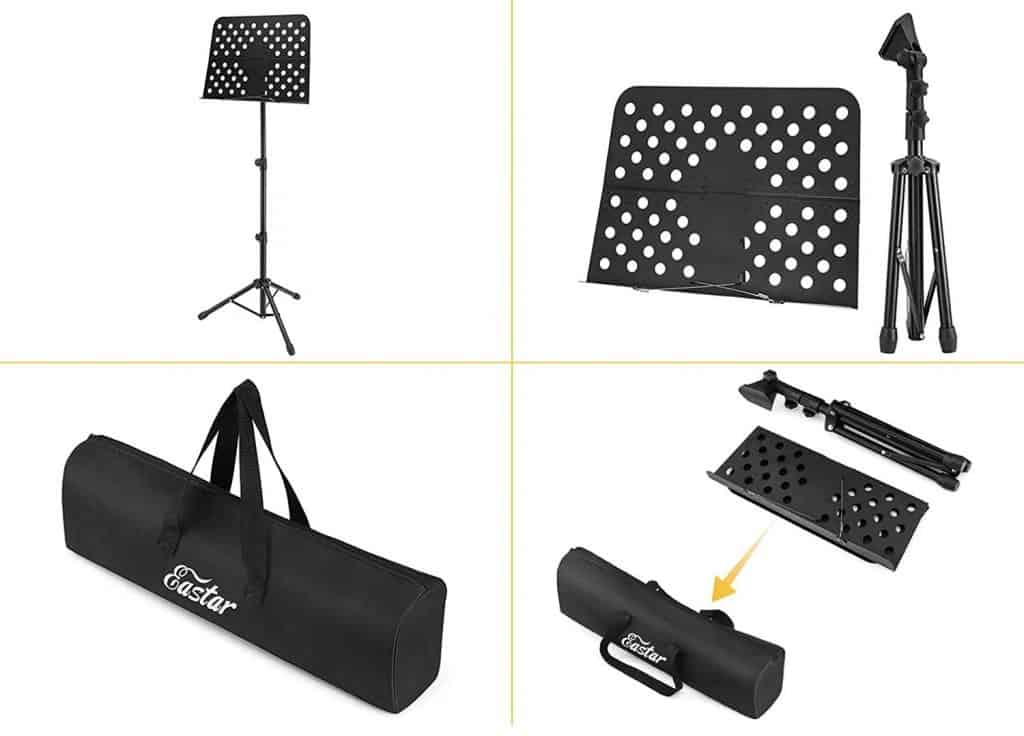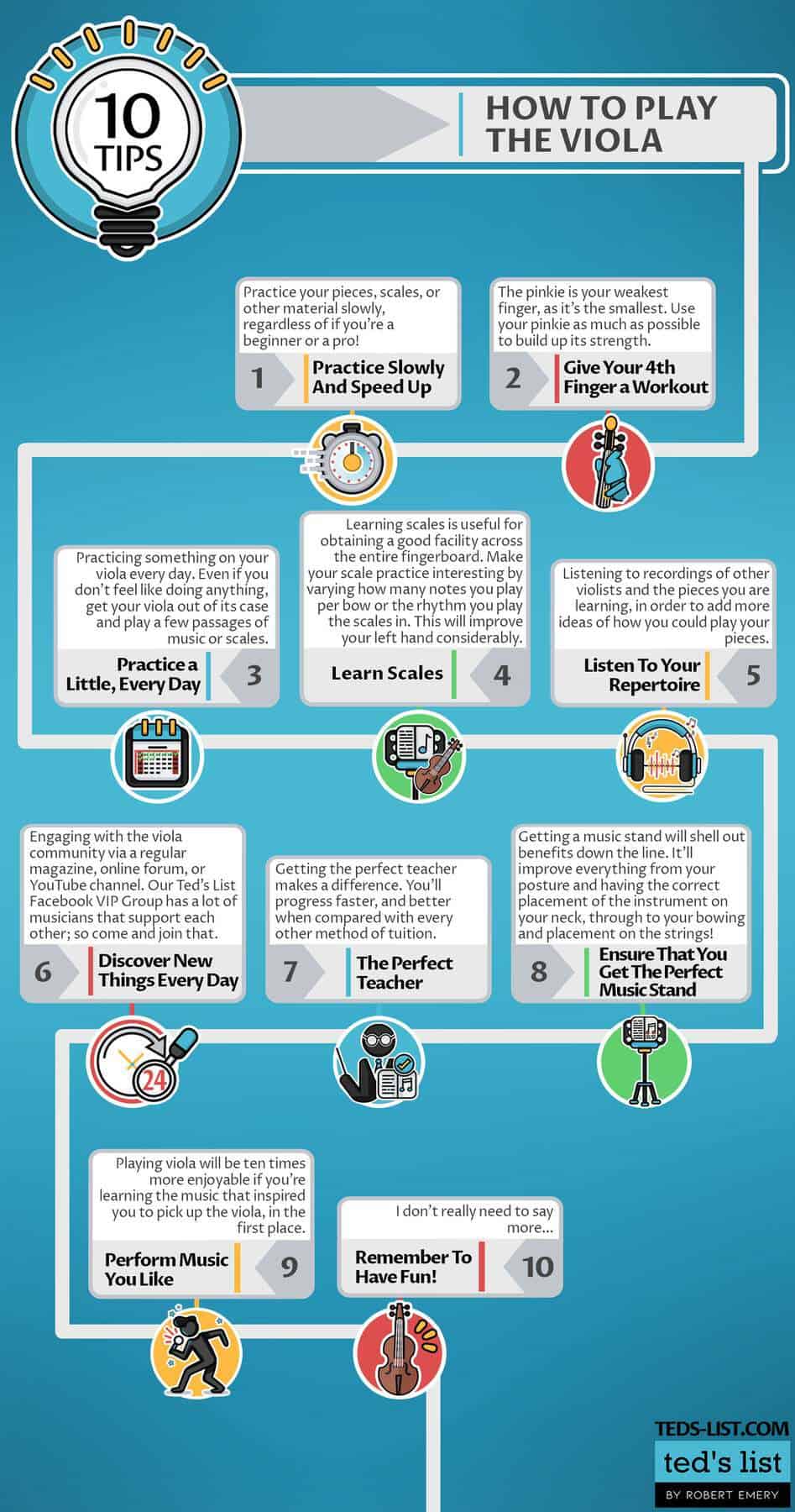Playing the Viola can be tough, as well as one of the most amazing instruments to play. That’s why we thought a summary of 10 tips to learn the Viola would help.
But what exactly is the easiest method to get started on your instrument?
How do you play viola and have fun whilst sustaining progress?
Well, it’s all about your practicing strategies. Viola music isn’t the simplest music in the world to perform, so it’s critical to get a powerful technique of practice to start you off in the proper direction.
So the following is our list of 10 top tips to help you get on the way…
Practice slowly and speed up
Whatever level you are, the best piece of advice you can be given is to practice your pieces, scales, or other material slowly. This applies to all violists, regardless of if you’re a beginner violist or a professional! This will ‘teach’ your muscles how to play the notes and then, as they become more familiar with them, you can gradually speed it up.
And whilst you’re doing this, you can check your bow technique too – your bowing can make or break your playing!
Give your 4th finger a workout
For all viola players, the pinkie is your weakest finger, as it’s the smallest. Even if you’re a beginner, don’t avoid using the pinkie on your left hand by using open strings in its place! Use your pinkie as much as possible to build up its strength- it’s so useful to have a good fourth finger which is as useful as the other three fingers!
Now get those fingers moving…
Practice a little, every day
Grab your bow, and try to practicing something on your viola every day. Even if you practice your instrument for several hours on Monday and you don’t feel like doing anything on Tuesday, get your viola out of its case and play a few passages of music or scales. By reducing the amount of time between your practice sessions, you will keep your muscles supple and will make swifter progress as a result.
Remember to make a routine around your practice. If you wish to play well then you’ll need to practice well, and it’s tips such as this that’ll produce the world of difference to your playing, sound, and tone.
A well-organized practice routine will provide you with direction and concentration during those important practice hours.
Out of all of these tips on learning Viola, this particular one is the thing that can easily make a huge difference rapidly.
Learn scales
For some reason, many violists think scales are boring and a chore. They are, in fact, so useful for obtaining a good facility across the entire fingerboard. Make your scale practice interesting by varying how many notes you play per bow or the rhythm you play the scales in. This will improve your left hand considerably.
Listen to your repertoire
I would always recommend listening to recordings of other violists and the pieces you are learning, in order to add more ideas of how you could play your pieces. You should always have your own thoughts of how a piece should sound, but there’s no harm in hearing what other players do.
You can decide whether or not you like the way they play these pieces and take ideas that you do like into your own playing. It’ll improve everything from your sound and tone, through to the placement of the bow on the string; and you won’t even know it! And one day, you’ll be playing in that orchestra too…
Discover New Things Every Day
Studying an instrument like the Viola is a lot like going exploring. It only truly seems like it’s been worthwhile when you find new things.
A great way to do this is actually engaging with the Viola community via a regular magazine, online forum, or YouTube channel. Our Ted’s List Facebook VIP Group has a lot of musicians that support each other; so come and join that.
Mastering new things will broaden your horizons and keep you committed to improving your instrument.
The Perfect Teacher
This tip is incredibly crucial – get private lessons. Getting the perfect teacher makes a difference. Provided you can afford to have them, you’ll progress faster, and better when compared with every other method of tuition.
The real key element to bear in mind about having music lessons is that nothing is set in stone. Nothing is forever. If you don’t get on with the teacher as much as you thought you would; just quit having lessons and find someone else. It’s as easy as that!
Ensure That You Get The Perfect Music Stand
Getting a music stand is a simple thing to do, that’ll shell out benefits down the line. Out of everything in this article, this is by far the simplest tip to achieve! It’ll improve everything from your posture and having the correct placement of the instrument on your neck, through to your bowing and placement on the strings!
Having a collapsible stand is okay – especially in terms of having one for when you need to bring your own stand to a gig, recording session, or music lesson. In this case, we highly recommend this foldable stand. However, for 90% of your time playing, you are doing so at home.
It might be a little bit more expensive initially to purchase a foldable AND a non-collapsible – but you’ll spend less over time. Trust me when I say, the constant up and down of the collapsible stands does cause them to break easily – so if you can minimize the amount you do it (by using your non-foldable at home), then you’ll become the extremely pleased owner of two music stands that’ll endure for years!
We highly recommend this type of music stand. It is reliable, has great reviews, and I have one myself and think it’s great!
Perform Music You Like
This is an uncomplicated tip, but also one of the more useful. To put it simply, playing Viola will probably be ten times more enjoyable if you’re learning the music that inspired you to pick up the Viola, in the first place. That could be music for an orchestra or a solo piece. It doesn’t really matter…
If all that you do is play never-ending scales and arpeggios then it can feel just a little soulless and you’ll likely feel that you’re not getting anywhere.
On the other hand, when you can pick up the Viola right after a tricky day at school or work and chill out for the evening by playing through your favorite tunes, then you’ll associate playing the Viola with fun and pleasure.
And this experience will always keep you coming back to the Viola for more.
Remember to have fun!
I don’t really need to say more..
How to play the viola - top 10 tips
Summary
I hope these top 10 tips on how to play the viola have helped you, and that joining the violists club! If they have, please do leave a comment below…
Good luck!
Do you want to share this infographic on your site? Use this code...
FAQ's
You get better at viola playing simply by practicing. There is no shortcut! Listen to the sound you produce, and try to improve it. Now go and grab that bow…
It is hard to learn to play the viola. But also, it’s hard to learn any instrument. So if your heart and gut are longing for some fun with a viola, follow it! Now go and find your bow…
It doesn’t matter if you play the violin or viola, both instruments have similar learning curves, and therefore the viola is neither harder nor easier than the violin.














so, you’re saying if i listen to a bunch of viola music i’ll somehow play better? idk sounds kinda iffy to me. how does listening help you play something you can barely hold right
I just picked up the viola a few months back and finding tips like these has been super helpful in keeping me motivated. Especially the part about giving your 4th finger a workout – never realized how weak that lil guy was until I started playing. Any advice on how to keep it from cramping up? Practicing every day has been a game changer too. It’s amazing how much progress you can see just by sticking to a routine.
Hey Ellie, glad to hear you’re enjoying the viola! For that 4th finger cramp, make sure you’re not pressing too hard and take short breaks during your practice to stretch your fingers. Keeping it relaxed is key!
Playing the viola has never been easier!
Well I’m glad we could help…